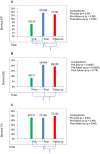Psychological distress, depression, anxiety, and burnout among international humanitarian aid workers: a longitudinal study
- PMID: 22984592
- PMCID: PMC3440316
- DOI: 10.1371/journal.pone.0044948
Psychological distress, depression, anxiety, and burnout among international humanitarian aid workers: a longitudinal study
Abstract
Background: International humanitarian aid workers providing care in emergencies are subjected to numerous chronic and traumatic stressors.
Objectives: To examine consequences of such experiences on aid workers' mental health and how the impact is influenced by moderating variables.
Methodology: We conducted a longitudinal study in a sample of international non-governmental organizations. Study outcomes included anxiety, depression, burnout, and life and job satisfaction. We performed bivariate regression analyses at three time points. We fitted generalized estimating equation multivariable regression models for the longitudinal analyses.
Results: Study participants from 19 NGOs were assessed at three time points: 212 participated at pre-deployment; 169 (80%) post-deployment; and 154 (73%) within 3-6 months after deployment. Prior to deployment, 12 (3.8%) participants reported anxiety symptoms, compared to 20 (11.8%) at post-deployment (p = 0.0027); 22 (10.4%) reported depression symptoms, compared to 33 (19.5%) at post-deployment (p = 0.0117) and 31 (20.1%) at follow-up (p = .00083). History of mental illness (adjusted odds ratio [AOR] 4.2; 95% confidence interval [CI] 1.45-12.50) contributed to an increased risk for anxiety. The experience of extraordinary stress was a contributor to increased risk for burnout depersonalization (AOR 1.5; 95% CI 1.17-1.83). Higher levels of chronic stress exposure during deployment were contributors to an increased risk for depression (AOR 1.1; 95% CI 1.02-1.20) comparing post- versus pre-deployment, and increased risk for burnout emotional exhaustion (AOR 1.1; 95% CI 1.04-1.19). Social support was associated with lower levels of depression (AOR 0.9; 95% CI 0.84-0.95), psychological distress (AOR = 0.9; [CI] 0.85-0.97), burnout lack of personal accomplishment (AOR 0.95; 95% CI 0.91-0.98), and greater life satisfaction (p = 0.0213).
Conclusions: When recruiting and preparing aid workers for deployment, organizations should consider history of mental illness and take steps to decrease chronic stressors, and strengthen social support networks.
Conflict of interest statement
Figures


References
-
- Lopes Cardozo B, Holtz T, Kaiser R, Gotway CA, Ghitis F, et al. (2005) Mental health of expatriate and Kosovar Albanian humanitarian aid workers. Disasters 29: 152–70. - PubMed
-
- Antares Foundation. Managing stress in humanitarian workers: guidelines for good practice. 2nd ed. Amsterdam, Netherlands: Antares Foundation, (2006). Available: http://www.antaresfoundation.org/download/managing_stress_in_humanitaria....Accessed 2011 Nov 29.
-
- Lopes Cardozo B, Salama P (2001) Mental health of humanitarian aid workers in complex emergencies. In: Danieli Y, ed. Sharing the front line and the back hills: international protectors and providers: peacekeepers, humanitarian aid workers and the media in the midst of crisis. Amityville, NY: Baywood Publishing. pp. 242–255.
-
- Eriksson CB, Vande Kemp H, Gorsuch R, Hoke S, Foy DW (2000) Trauma exposure and PTSD symptoms in international relief and development personnel. J Trauma Stress 14: 205–212.

